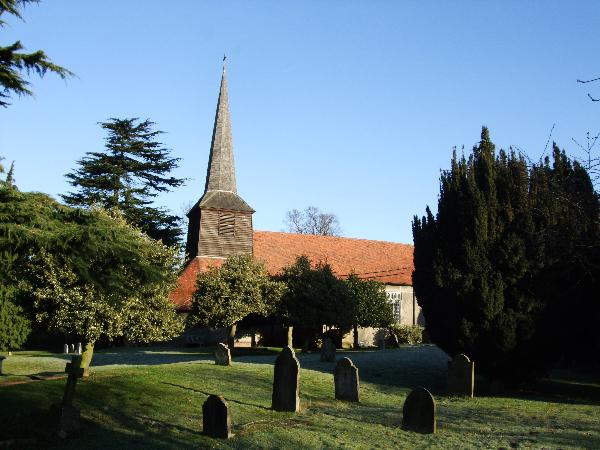St Thomas the Apostle, Navestock

The church of St Thomas the Apostle consists of nave, chancel, south aisle, and western belfry with spire. The belfry is one of the notable timber towers of Essex. The rest of the church is of flint rubble and pebbles plastered externally, with dressings of limestone and clunch. The roofs are tiled and the spire shingled. The church dates from the 11th or 12th century but was largely rebuilt in the 13th and 14th centuries.
The north wall of the nave is part of the 11th-century church. The north doorway has a plain tympanum under a semicircular arch. Below this a segmental arch is ornamented with rounded billets. The door itself may also be of 11th- or 12th-century date.
In the 15th century the south porch and the belfry were added. The belfry is timber-framed. The walls were formerly weather-boarded but have now been plastered. Round the base is a semi-octagonal aisle which once contained vestries. The central framework consists of four heavy oak posts with attached octagonal columns at their internal angles. The bell chamber has a louvred opening in each face and is surmounted by a shingled spire.
In post-medieval times, probably in the early 19th century, alterations were made inside the church and the oak pier and arches put in the south arcade. This pier is roughly cut to a polygonal shape and has a moulded cap and a brick base. The wooden arches springing from it are rough and plain and the whole has been covered with plaster to resemble the rest of the arcade. There are similar wooden arches across the nave and aisle at this point springing from semicircular responds, also of plastered wood with moulded plaster caps.
Late in the 19th century the church was restored, the tower and spire being repaired in 1897. The west wall of the nave, which is of brick, was probably put in at this time. The roofs of nave and chancel also appear to have been renewed in the 19th century.
On 21 September 1940 a landmine fell in the churchyard near the south-west corner of the church. The south porch was destroyed, the belfry badly damaged, and much of the roof stripped of tiles. There was also considerable damage to the interior. A complete restoration of the church started in 1954. The site of the bomb crater is now occupied by a garden of remembrance.
There are five bells, the first being of 1862 but the others older. The third is by John Walgrave and probably dates from about 1420-50. It has the inscription 'Sancta Katerina Ora Pro Nobis'. The fourth is by John Hardyng and of about 1560 and the second and fifth by Miles Graye, 1637.
There are several brasses on the walls of the chancel, the oldest being to Richard Makyn (1603) and his wife Agnes (Colford) (1589), and to James Makyn (1616). On one of the window-jambs is a brass to John, son of Edward Moore (1624), a cursitor of the Chancery.
In all my travels around the Essex churches, this is the only one that has a CCTV camera.
The cache
You’re looking for a 35mm film canister. The cache has a log book but no pen so please bring one with you.
Church Micro Series
If any body would like to expand to this series please do, could you please let sadexploration know first so he can keep track of the Church numbers and names to avoid duplication.